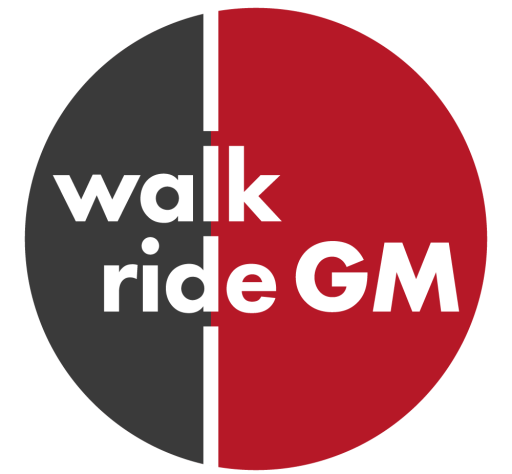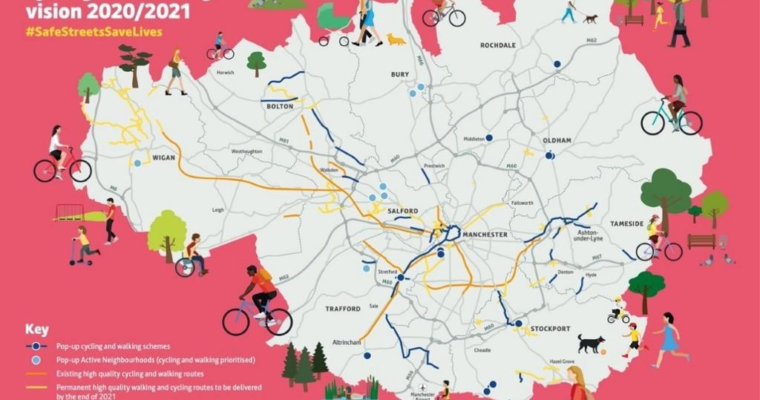The recent news that the Bee Network is upping the pace shows, we hope, that we are entering a new phase of delivery of walking and cycling in Greater Manchester.
While announcements included no new schemes, no new money – and were essentially a recap of 26 previously announced schemes – this is a welcome new focus on getting them in by the end of 2021.

Of the £160m Mayor’s Challenge Fund, which is to pay for the first few years of the Bee Network (and runs out in March 2022), only £15m has been spent so far, with a further £48m of schemes ‘given programme entry’ ie provisionally greenlit and included in the commitments above.
What those announcements didn’t include is funding won through the Government’s Emergency Active Travel Fund second tranche, news of which has been delayed but is expected later in October, and other pots or matching funding which may be available, such as the Growth Fund.
There are positive noises that there is more to come from the Emergency Fund for GM (albeit a way off the 120km hoped for at one point) as per this summary:
- Tranche 1: 25 miles
- Tranche 2 (Town Centres): 18 miles
- Tranche 2 (Regional Centre): 6 miles
This map above includes the Bee Network schemes AND those hoped for from the Government’s Emergency Fund (we are really hoping that blue circle in the middle includes, finally, some temporary bike infrastructure in Manchester city centre).
All the details above are taken from a detailed three-year state of play report which went to the GM Transport Committee from TfGM’s new Programme Director of Walking and Cycling, Richard Nickson.
His paper commits to the following roll-out of Bee Network miles over the next two years – essentially this is what councils have signed up to deliver:
- By April 2021: 4 miles
- By April 2022: 88 miles (add 44 miles previous year)
- By April 2023: 126 miles (adds 38 miles on previous year)
Interesting also to hear the comments from Boardman at our recent webinar, that while quality remains the focus, if councils drag their heels, funding may be moved to councils with more capacity / capability to deliver.
“We have given schemes ‘programme entry’ {to the £160m+ Mayor’s Challenge Fund, which is paying for the first phase of the Bee Network} but it’s a time-limited fund.
“So if we aren’t seeing progress soon, we will start to look at reallocating funds to people who want to go quickly so we can start to inject some more pace.
Walk & Cycling Commissioner Chris Boardman
It was also good to see more than just cycle lanes in Nickson’s report: for instance the 18 safer crossings across Bury and Harpurhey, and more news on Active Neighbourhoods – which are a lot cheaper than bike lanes and arguably create a greater impact for more people, more quickly. As well as a promise for this to be the start of regular ‘progress checker’ reports.

The Director’s reference to publishing long awaited design standards, under the Streets for All work that was done more than a year ago now, was also welcome. As was acknowledging that TfGM can do more to support borough business cases, and communicate more.
Boardman and his team have in total £500m worth of plans for 420 miles of network, for which they’ve asked for another £215m from Government via the Build a Nation report at the start of the year.
The Bee Network team have never seemed too troubled by this funding gap (which to be fair shouldn’t be a problem given the £2bn announced as part of Gear Change (though that was before our fall out with Westminster…).
Perhaps more important is the Government’s commitment to deliver on its this strategy – Transport Minister Grant Schapps’ recent letter to local authorities has been seen by some as a worrying sign of back-pedalling, giving councils a way off the hook in the face of even a glimmer of opposition.
It’s emerged in the last few days that one borough appears to have wobbled – with news Bury is planning to pull their A56 pop-up bike lane scheme. But then came news of Bolton joining the race with a fantastic set of proposals for the town centre. There are steps forward, there are steps back – it’s a crucial 12 months when we will learn definitively where the political will for change is to be found.
Our 10 leaders have all signed up to Made to Move, the GM Green Plan, a Climate Emergency and numerous other policies which all commit them to increasing walking and cycling and reducing driving – by at least 1m fewer car journeys a day in GM.
So while we need many things – we need stronger leadership to support a clear plan of action for how this shift will happen in each borough.
To be fair, it’s still early days in what is a major transformation.
But perhaps in addition to delivery we need a new focus on team-work.
Neither the GMCA, TfGM nor the councils hold the answer alone – none of us do.
This month we also saw the launch of the Active Travel manifesto by the Public Health Directors of GM. And GM Moving is the multi-agency campaign to get more people moving in their daily lives. It is also good to see TfGM’s new Cycle & Stride grant scheme for under served groups.
If we are to make this shift, we all need to work together more on making these small parts into a greater whole – through communication, collaboration and community engagement.
If team-work is the next phase: How and where does that happen, we wonder?


One reply on “BEE NETWORK’S THREE-YEAR PROGRESS REPORT: THE WALKRIDE GM VIEW ”
[…] been three years since walking and cycling Commissioner Chris Boardman’s vision and plan to transfo… was agreed by the GM Combined Authority* – so we thought it would be a good time to take a […]